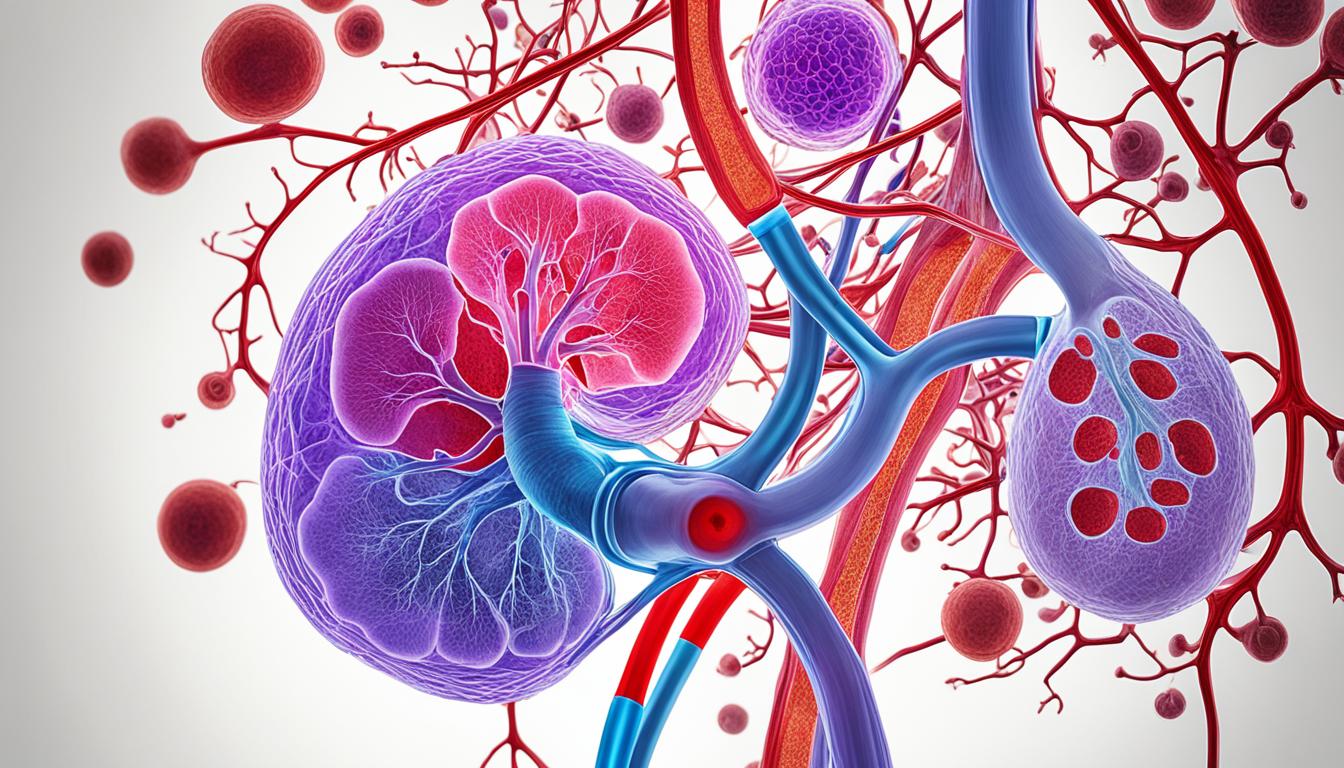Hydronephrosis is a common disease that can happen to anyone. It’s usually due to a blockage after the kidney. This blockage can arise from many causes, such as injuries to the urinary tract. When a blockage occurs, urine can’t flow from the kidney to the bladder. This leads to swelling in the kidney and parts of the urinary system above the blockage point.
This swelling can affect one or both kidneys. It hurts the kidney’s job and can even hurt its cells. If not treated, it can cause serious problems. These include damage to the kidney that can’t be undone. It also leads to changes in the body’s minerals and a buildup of waste products.
Key Takeaways:
- Hydronephrosis is a common disease affecting people of all ages.
- It is caused by post-renal obstruction that prevents the flow of urine from the kidney to the bladder.
- Dilation of the renal calyces and ureters can impair kidney function and damage kidney cells.
- Untreated hydronephrosis can cause irreversible kidney damage and electrolyte imbalances.
- Stem cell therapy offers a potential breakthrough for the treatment of hydronephrosis.
Causes and Diagnosis of Hydronephrosis
Hydronephrosis happens when things block the tubes of your kidneys. This causes swelling because urine can’t flow as it should. It’s important to find out why this is happening so doctors can treat it and stop kidney harm.
For kids, trouble with how their urinary tract formed can lead to hydronephrosis. Issues like narrow ureters, kidney infections, urine backing up, and nerve problems can mess up peeing. This can make the kidneys swell.
In grown-ups, kidney stones are a common issue. They can get stuck in the tubes, blocking urine. Other things like tight ureters, problems with the bladder or urethra, nerve problems, and a big prostate can also cause hydronephrosis.
Doctors find hydronephrosis mostly through a patient’s story, a check-up, and special tests. These tests include ultrasounds, CT scans, MRIs, or an IVP. They show doctors what’s going on inside to pinpoint the issue. More tests might be needed to check how well the kidneys are working and if they drain urine right.
Spotting and treating hydronephrosis early can save the kidneys. After finding the cause, doctors make a plan just for you. This helps fix the problem, so you feel better and stay healthy.
Summary of Causes and Diagnosis of Hydronephrosis
| Cause | Description |
|---|---|
| Congenital malformations of the urinary tract | Problems with how the urinary tract forms can cause hydronephrosis in kids. This includes ureter narrowness, infections, and nerve issues. |
| Urinary tract stones | Stones that block the kidney tubes are a key cause in grown-ups. |
| Ureteral strictures | Blockages in the ureter due to growth or diseases can also cause the kidneys to swell. |
| Neurogenic bladder | Conditions affecting the bladder’s nerve control lead to urine flow problems. |
| Prostate enlargement | A big prostate can block the tube that carries urine, causing issues. |
| Bladder neck stricture | Narrowing at the opening of the bladder can block the urine flow. |
| Urethral stricture | Narrowing of the urethra stops urine from flowing out, swelling the kidneys. |
Breakthroughs in Stem Cell Therapy for Hydronephrosis
The way we treat hydronephrosis has gotten much better in recent years. This brings new hope to people with the condition. Stem cell therapy has made a big difference, showing good results in helping the kidneys heal.
Stem cell therapy is a new way to fix kidney damage. It uses special cells to replace or repair hurt tissues. This can help people with kidney problems because their urine flow is blocked. The treatment is very promising for these patients.
Sometimes, surgery is needed, but there are less invasive options now. Laparoscopic surgery is a type of keyhole surgery. It’s safer and people recover more quickly with this method. It’s a great choice for kidney problems like when tubes are too narrow.
For those with kidney stones, doctors have different surgeries to help. These surgeries safely remove the stones. This eases the symptoms and lets urine flow normally again.
Thanks to stem cell therapy and better surgeries, treating hydronephrosis is more effective now. These treatments are less hard on the body. They can make kidney health better and keep you feeling well.

